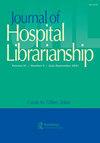SWOT/TOWS/OTSW Analysis of Recent Past and Near Future
Q3 Social Sciences
引用次数: 0
Abstract
One can conclude that life from March 2020 to summer 2021 and even to the present has been most interesting for hospitals and hospital librarians. A few hospital librarians stayed in place and kept their libraries open but with masks as the new normal. Many libraries closed doors but offered remote services. When doors reopened, plexiglass partitions were put into place and social distance measured. Unfortunately, some librarians lost their jobs and hospital library doors closed permanently. This author took her digital library home and postponed an ambitious rounding schedule until summer 2021. This is a perfect time for all hospital librarians to conduct honest personal and strategic reflections on the hospital library’s programs and services. A librarian can do this alone or in a group and can use a recognized strategic analysis technique. Analyzing strengths, weaknesses, opportunities and threats using the SWOT model or a similar matrix, such as TOWS or OTSW, helps to identify favorable or unfavorable internal and external factors to achieve goals. Strengths and weaknesses identify internal factors from within the organization that can be manipulated or controlled. The internal analysis identifies resources, capabilities, and core competencies as well as the hospital librarian’s and the library’s competitive advantages. Consideration should be given to finances, management style, suppliers, marketing, planning and innovation (1). The external analysis identifies opportunities and threats that need to be overcome, usually from outside over which the library and librarian may have no control. If completed successfully, the SWOT/TOWS/OTSW analysis will create an action plan. SWOT analysis is composed of the following elements (Figure 1). Strengths demonstrate tangibles and intangibles that the library does well, whereas weaknesses expose what a library does not do well. Opportunities offer favorable conditions to move programs and services forward and threats reveal conditions for unfavorable happenings. At the conclusion of the SWOT analysis the hospital librarian can clearly realize an action plan to improve weaknesses, capitalize on strengths and opportunities and stand firm against threats. Another way to consider results of the analysis is taking advantage ofSWOT/TOWS/OTSW分析最近的过去和不久的将来
可以得出结论,从2020年3月到2021年夏天,甚至到现在的生活对医院和医院图书馆员来说都是最有趣的。一些医院图书馆员留在原地,保持图书馆开放,但戴口罩是新常态。许多图书馆关闭了大门,但提供远程服务。当门重新打开时,安装了有机玻璃隔板,并测量了社交距离。不幸的是,一些图书馆员失去了工作,医院图书馆的大门永久关闭。这位作者把她的数字图书馆带回家,并将雄心勃勃的四舍五入计划推迟到2021年夏天。这是所有医院图书馆员对医院图书馆的计划和服务进行诚实的个人和战略反思的最佳时机。图书管理员可以单独或集体完成这项工作,并可以使用公认的战略分析技术。使用SWOT模型或类似矩阵(如TOWS或OTSW)分析优势、劣势、机会和威胁,有助于识别有利或不利的内部和外部因素,以实现目标。优势和劣势确定了组织内部可以操纵或控制的内部因素。内部分析确定了资源、能力和核心竞争力,以及医院图书馆员和图书馆的竞争优势。应考虑财务、管理风格、供应商、营销、规划和创新(1)。外部分析确定了需要克服的机会和威胁,通常来自图书馆和图书管理员可能无法控制的外部。如果成功完成,SWOT/TOWS/OTSW分析将创建一个行动计划。SWOT分析由以下要素组成(图1)。优势展示了图书馆做得好的有形和无形的东西,而弱点则暴露了图书馆做不好的东西。机遇为推进项目和服务提供了有利条件,而威胁则揭示了不利事件的发生条件。在SWOT分析的结论中,医院馆员可以清楚地实现一个行动计划,以改善弱点,利用优势和机会,坚定地面对威胁。另一种考虑分析结果的方法是利用
本文章由计算机程序翻译,如有差异,请以英文原文为准。
求助全文
约1分钟内获得全文
求助全文
来源期刊

Journal of Hospital Librarianship
Social Sciences-Library and Information Sciences
CiteScore
1.00
自引率
0.00%
发文量
43
期刊介绍:
The Journal of Hospital Librarianship is the first journal to specifically address the issues and concerns of librarians and information specialists in the field of hospital librarianship. This peer-reviewed journal focuses on technical and administrative issues that most concern hospital librarians, providing a forum for those professionals who organize and disseminate health information to both clinical care professionals and consumers. The Journal addresses a wide variety of subjects that are vital to the field, including administrative, technical and program issues that may challenge hospital librarians. Articles published in the Journal focus on research strategies, administrative assistance, managed care, financing, mergers, and more.
 求助内容:
求助内容: 应助结果提醒方式:
应助结果提醒方式:


